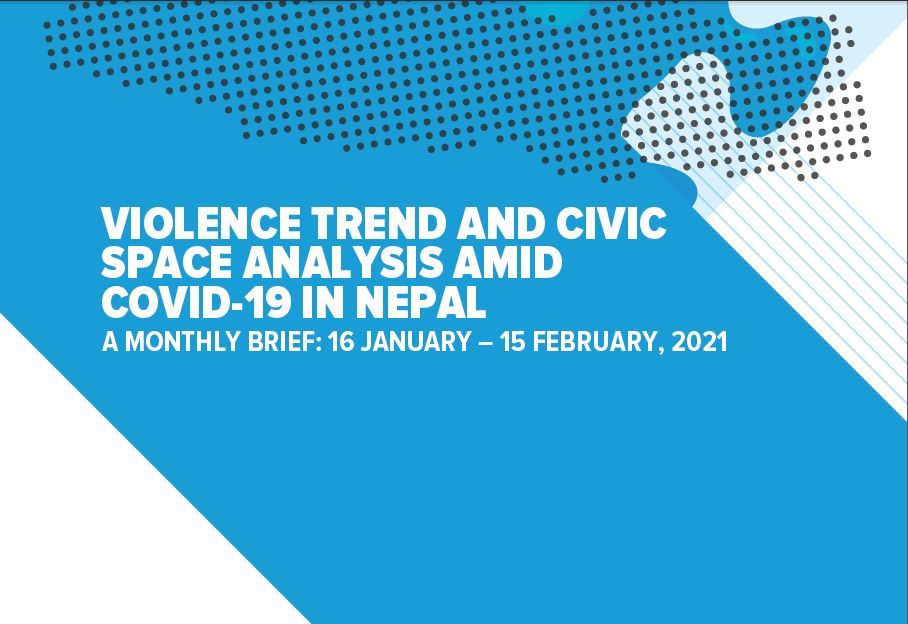Analysis
VIOLENCE TREND AND CIVIC SPACE ANALYSIS AMID COVID-19 IN NEPAL, 16 JANUARY – 15 FEBRUARY, 2021
2021-03-03

This report from Violence Monitoring and Shrinking Civic Space in Nepal amid Covid-19 (VMSCS) Project evaluates the trends of violent and non-violent contestation with the objective of presenting their impact on civic space in Nepal from 16 January to 15 February 2021. Data of violent and non-violent incidents are compiled from reports mapped by NepalMonitor.org, which uses a broad range of information from all major online news portals, national and local newspapers, Nepal Police, Civil Society Organizations (CSOs) working for human rights, and incident reports directly submitted to the Collective Campaign for Peace (COCAP).
OVERVIEW OF INCIDENTS
From 16 January to 15 February 2021, a total of 463 incidents were recorded. Compared to the previous month (16 December 2020-15 January 2021), there was an increment of incidents by 25.13%. Of the total incidents recorded, 197 incidents were violent and 266 incidents were non-violent. The violent incidents injured 78 people and took the lives of 34 people.
The violent incidents mainly involved group clash, violent demonstrations, arson, vandalism, assault, sexual assault, murder, infanticide and symbolic violence (pressure cooker bomb planted by Biplav led group to manifest power and threat to the country).
The non-violent incidents included peaceful demonstrations, sit-ins, arrests, roadblocks and strike/bandh.
CIVIC SPACE SITUATION AMID COVID-19
The state of civic space in Nepal has been progressive with the development of every new constitution over the years. The most recent Constitution of Nepal, promulgated by the constituent assembly in 2015, guarantees the freedom of expression and association, as well as the right to assemble peacefully. Despite these efforts, the state of civic space in Nepal continues to obstruct, especially for those who congruously make use of their rights to stand against injustice. The pandemic has also added to this obstruction, limiting the exercise of rights and freedom. It has also allowed the government to gain more control over civic space, from inconsistency in their approach toward CSOs to tabeling of various legislative measures and the suppression of peaceful protestors in an attempt to silence all forms of criticism.
THREATS AND ATTACKS AGAINST JOURNALISTS AND HUMAN RIGHTS DEFENDERS
This month saw incidences of violation of freedom of expression and civil rights. From 16 January - 15 February, Human Rights Defenders (HRDs), Journalists, media persons, and a media house faced challenges in carrying out their work often facing mistreatment, threats, intimidation, and violent physical attacks. For instance, on 22 January, 5 Women Human Rights Defenders (WHRDs) were assaulted by Assistant Sub Inspector of Police Kamal Bhattarai of Area Police Office Lahan district while the WHRDs had gone to help a 20-year-old pregnant victim of domestic violence, who was kept in a shelter on December 26. According to Renu Karna, chairperson of the Women’s Human Rights Defenders Network, the HRDs took the victim to the Area Police Office, Lahan, after the police called both parties for reconciliation but according to Karna, the victim was grabbed by the hand and taken out of the office under the direction of Inspector Suryanarayan Majhi.1 On January 26, former minister Mahesh Basnet publicly threatened 3 media editors at a public event in Butwal saying that some media outlets had spread chaos in the name of democracy. The Federation of Nepali Journalists (FNJ) then issued a statement on January 28 stating it as direct interference in the freedom of the press.2 On 4 February, a journalist was jointly abused and physically assaulted by a former minister, former mayor and other leaders of NCP while reporting during the general strike called by the Prachanda-Nepal faction of NCP in Kanchanpur, far-west province.3 Likewise, 2 media persons including a journalist of an online news portal and a TV reporter were physically assaulted by Dahal-Nepal cadres in Koteshwar.
POLICE INTERVENTION DURING THE PEACEFUL PROTESTS
This month observed episodes of peaceful demonstrations from the different political parties, civil society members and rights defenders, of which the majority of the protests were around the dissolution of the House of Representatives (HoR). 5 incidents of a clash between the protesters/demonstrators and the security forces were witnessed this month, of which, 3 incidents were around the dissolution of the HoR by the Prime Minister KP Sharma Oli, which many considered to be undemocratic and unconstitutional as the constitution of Nepal does not allow the Prime Minister to do so.5 The security personnel used excessive force to suppress the peaceful protest using water cannons, and batons charging the crowd in order to disperse them. For instance, on 25 January, 12 people were injured during the protest in Baluwatar, after police used force to control the crowd and tried to curtail the civilian rights to freedom of expression, and freedom to assemble peacefully. Over 20 human rights activists were detained by the police while protesting against the government’s move to dissolve the HoR. Similarly, 4 people were injured in a clash between the police and the demonstrators in Dhading, after the symbolic torch rally organized by the Prachanda-Madhav faction on 04 February.
To read the complete report, please download the attached PDF.

